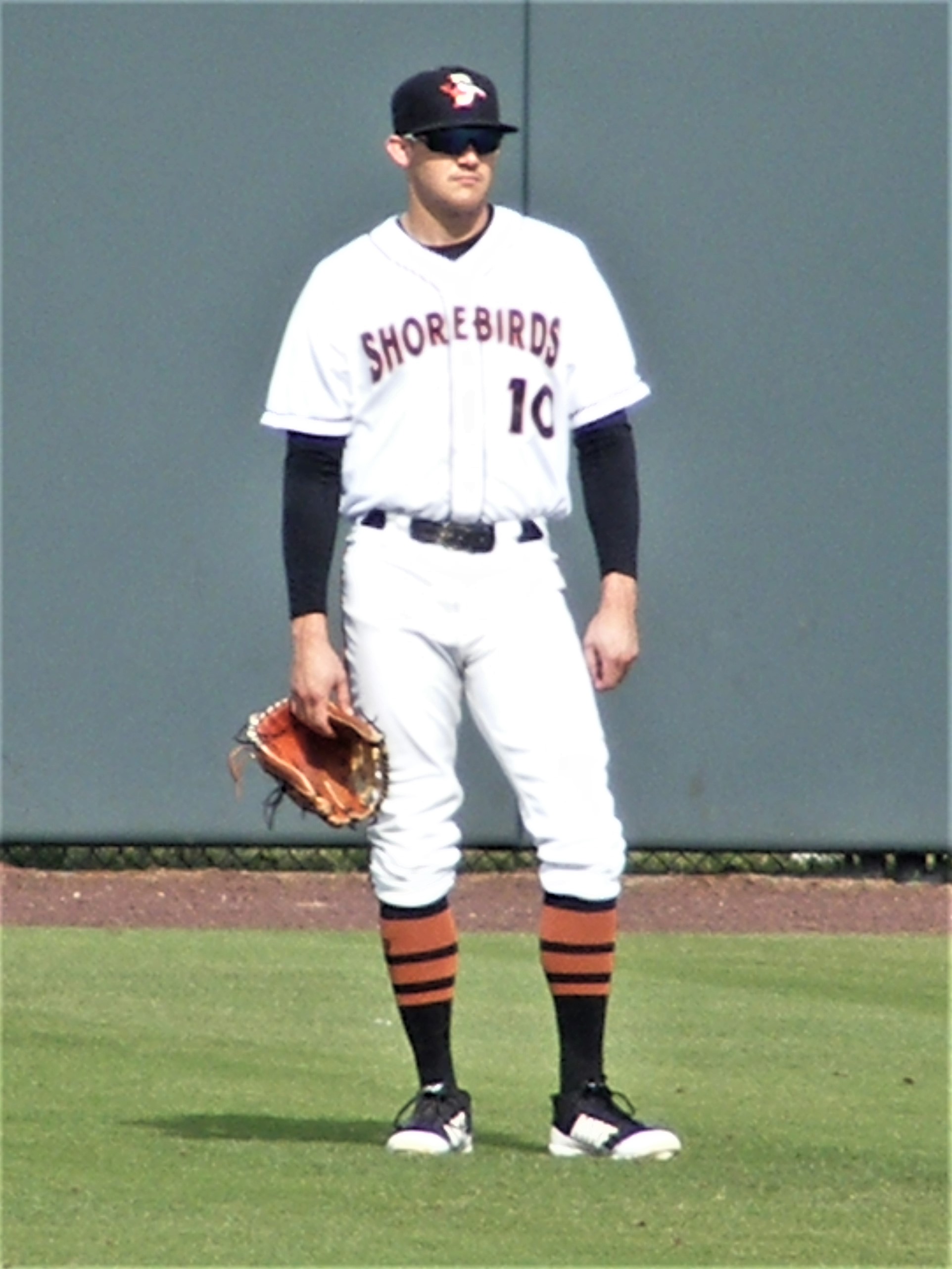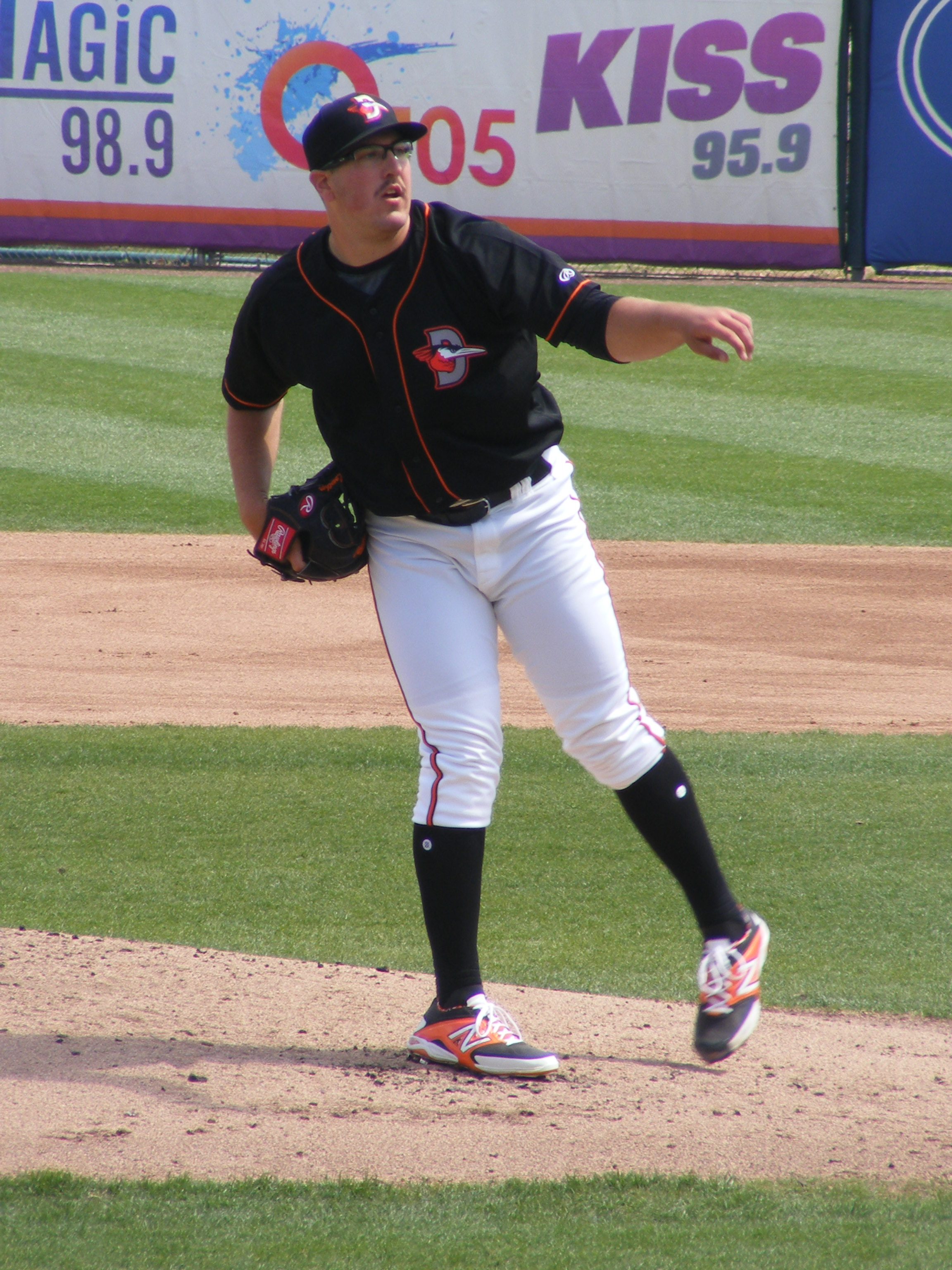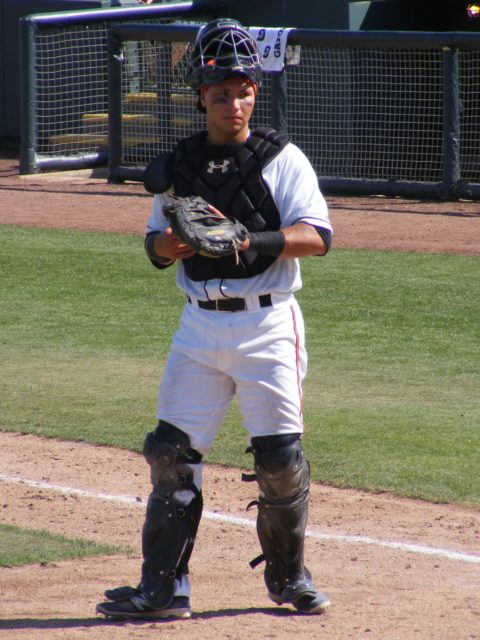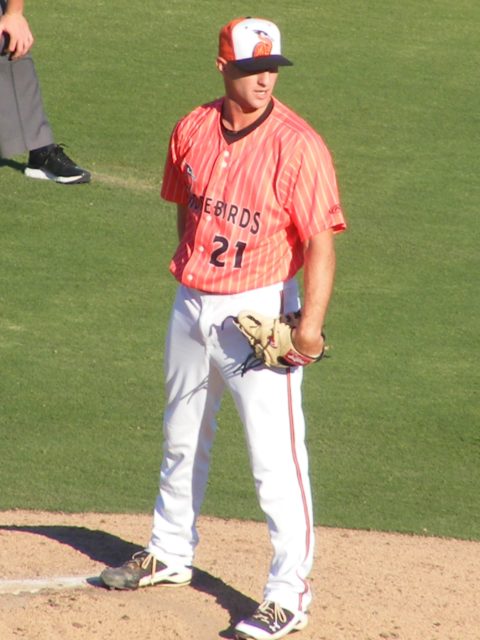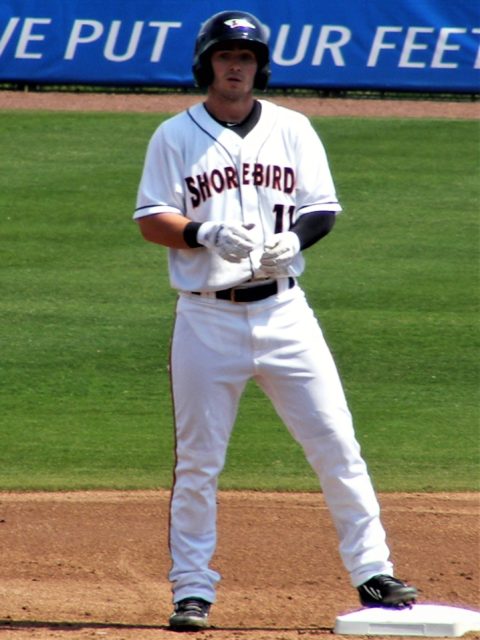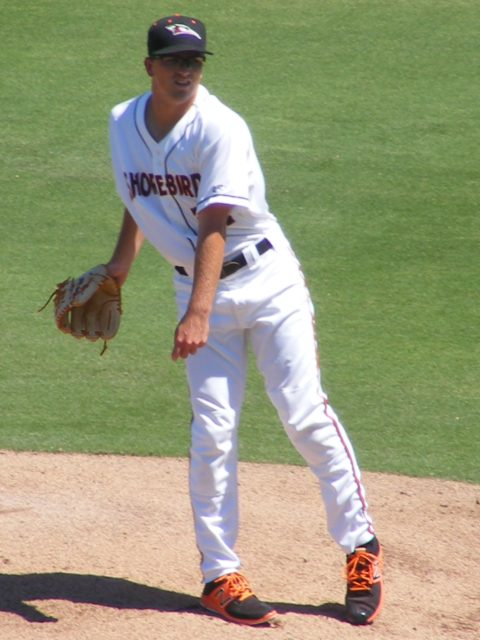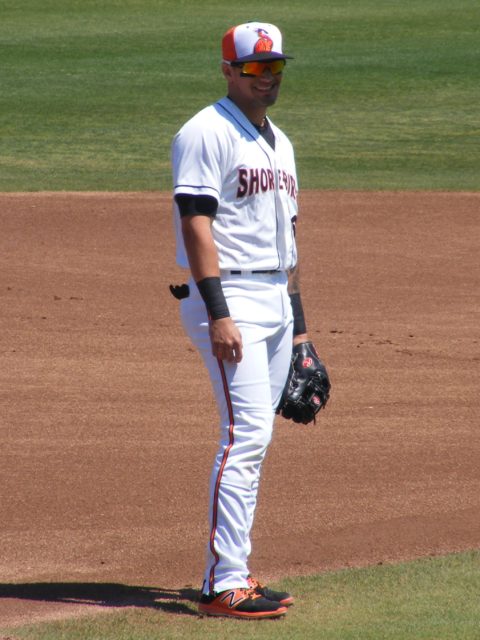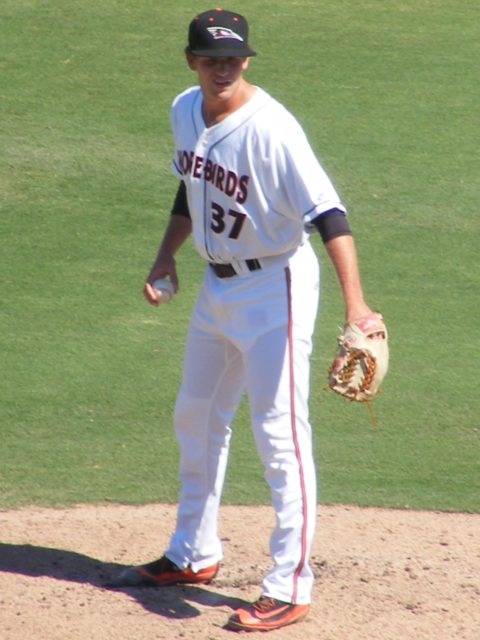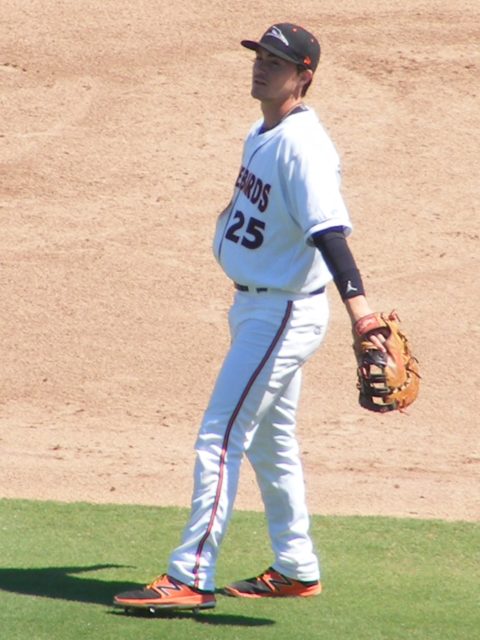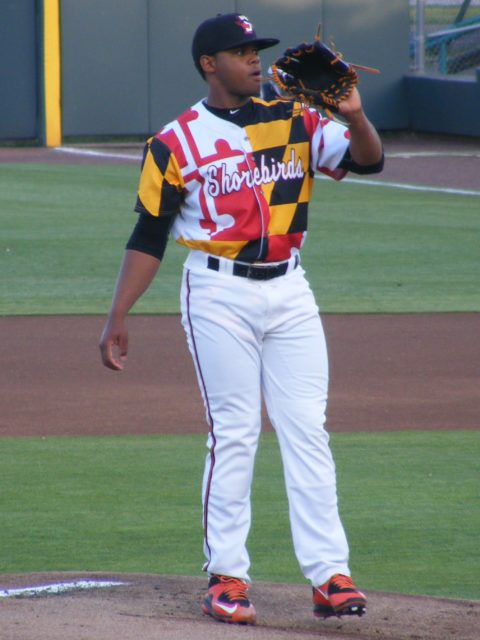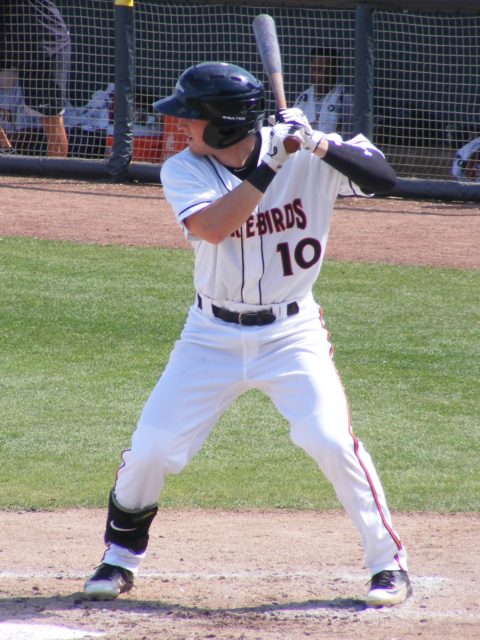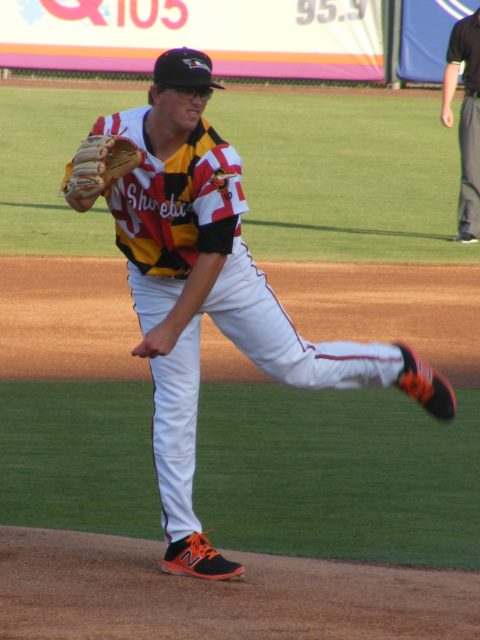Well, we had two good seasons in a row, anyway.
After a six-year run of losing, the Shorebirds reverted to their winning ways of old in 2015 and 2016, but that streak came crashing down this season thanks to one of the more mediocre squads the Orioles have sent us in some time. With the Orioles passing prospects like Cody Sedlock, Keegan Akin, and Austin Hays – who recently made his Orioles debut – from Aberdeen straight to Frederick, we were left with a team that followed up a 29-39 first half with a nearly identical 30-39 second half. The shame of it was that Delmarva was in first place in the second half as late as July 29 with a 20-13 record after completing a perfect 7-0 road trip to Georgia. (It was their first perfect two-stop road trip in at least 12 years.) But the next day a doubleheader loss to Greensboro set the Shorebirds on a 12-game losing streak that plunged them out of contention and began an August where they went 9-20 – from the high point Delmarva lost 26 of their last 36 games.
So the 59-78 mark was their worst since a 54-82 mark in 2013 and it ended a run of improvement each year since. Overall, it was a team that wasn’t particularly great in any main category of offense, pitching, or defense.
- A .240 team batting average was next to last in the league, with Columbia’s .234 the only team holding them up.
- Consequently the team was only 11th in runs and hits, scoring just 544 times on 1,108 hits.
- The 229 doubles was good for fifth in the loop, and they were eighth with 31 triples.
- They were ninth in the league in home runs with 77.
- We finished tied for 10th with 492 runs batted in.
- Back to 11th we went in total bases with 1,630.
- We drew 341 walks, which – you guessed it – ranked 11th in the SAL.
- One dubious category was strikeouts, where their 1,243 was the most in the league by 33 over Lexington (who played one more game.)
- In steals, we were 11th (as one might expect) with 91 stolen bases in 125 attempts. (This time, league-leading Asheville was caught more than we stole – 100 vs. 91.)
- Our .304 on-base percentage was next-to-last in the league (Lakewood was .301) and the .353 slugging percentage was eleventh. With those numbers our OPS of .657 was only better than Columbia’s .649 mark.
Our pitching was only slightly better when compared to the rest of the league, as we finished ninth in ERA with a 3.79 mark.
Some other pitching numbers:
- Our 9 shutouts was also ninth in the loop.
- We tied for 12th in saves with 29, with Augusta last with 23.
- We tied for seventh in innings pitched with 1,204 1/3.
- 1,210 hits allowed was 11th. Matching the rank in ERA it follows the 613 runs and 507 earned runs we gave up were also ninth.
- Allowing 94 home runs was tenth.
- While we only had 71 hit batters (good for fourth) we were also fourth with 354 walks allowed.
- While our staff had a nice, round number of 1,000 strikeouts it was the fewest in the league.
- Finally, our WHIP (walks + hits/innings pitched) was ninth in the league at 1.30.
With 136 errors and a .973 aggregate fielding percentage our defense was right at league average.
Help may be on the way, though. Below us in the Orioles organization Aberdeen was 41-34 (contending until the final days for a wild-card spot) and the GCL Orioles closed 28-32 while the single Dominican Summer League team (down from 2 in recent years) the Orioles provided players for wrapped up a 32-37 season. Ahead of us, Frederick made the Carolina League playoffs despite a 68-71 record and Bowie did the same in the Eastern League with a 72-68 record. (Both lost in their respective opening rounds.) Norfolk also finished below .500 with a 66-76 record. So as a whole the talent pool may be worse than average, although individual players from the lower levels may combine for a better team.
With a switch from weekly to monthly honors, going over those selected won’t take as long – so let’s review.
April player – Jake Ring
Jake began the season like he had something to prove after a somewhat bitter cup of coffee with the Shorebirds in 2016. It began by being the South Atlantic League’s first Player of the Week for the season and the Orioles’ minor league Player of the Month. Later on Ring was selected to the North’s All-Star team and a postseason All-Star despite a September promotion to Frederick. As a whole for Delmarva Ring hit .272/14/65/.785 OPS in 118 games, leading the team with 65 runs, leading the entire league with 36 doubles, and setting the pace for the Shorebirds with 212 total bases and a .457 slugging percentage. In almost every offensive category, Jake was among the team leaders.
However, the league seemed to catch up with Ring in the second half as he went from a .313 average at the All-Star break to a split of .232/5/24/.653 OPS in the latter stages. His brief callup to Frederick saw Ring go just 1-for-8, although that one hit was a home run. Ring was also the hero of the Keys’ lone playoff win, driving in the winning runs to cap off a ninth-inning comeback.
Yet the problems that led to a dearth of outfield talent in the organization to a point where the Orioles were experimenting (with varying success) with Christian Walker, Pedro Alvarez, and Trey Mancini suddenly seem to have disappeared as prospects like Cedric Mullins, D.J. Stewart, and Austin Hays are names being considered for the 2018 Orioles, with 2016 Shorebird Ademar Rifaela (the Carolina League MVP) close behind. With that glut on top of the organization, a player like Ring – who was a late-round draft pick and is a little older than his league competition at the low-A level – won’t be as highly regarded as he may have been a couple years ago. Notice that a solid player from that period like Mike Yastrzemski is barely regarded as a prospect despite his elite lineage.
I would look for Ring to continue in Frederick next season, but he will need to make more contact to avoid stalling out at that level. Getting his first 15 professional home runs in one season is nice, but 141 strikeouts is not. (SAL Player of the Week April 6-16, SAL All-Star, SAL Postseason All-Star)
April pitcher – Alex Wells
You knew Alex would be something good when his first four starts netted two wins and just two earned runs allowed, but the thing about Wells was that a bad month for him (like June, where he was 3-2 with a pedestrian 4.46 ERA) was a good month for many of the other Delmarva starters. Named as an SAL All-Star, Wells turned up the heat on opposing batters in the second half by quickly embarking on what would become the stuff of legend: a 68-inning walkless streak that carried through the end of the season. (This helped the Shorebirds lead all of baseball in walkless games from a pitching staff; meanwhile, the major league record for such a streak is 84 1/3 innings by Bill Fischer of the 1962 Kansas City Athletics.)
Even without the pinpoint control of allowing 10 walks in 140 innings, Wells put together a fine season that arguably should have nabbed him the league’s Outstanding Pitcher honors – in a case of highway robbery, the award instead went to Rome’s Joey Wentz. Wells finished 11-5 (2nd in wins), with a 2.38 ERA and 0.91 WHIP (both led the SAL) and 113 strikeouts. At home Wells was unbeatable, going 7-0 with a 1.75 ERA in 11 starts. Armed with a simple, easily repeatable delivery, Wells works at a pace that would make legendary “work fast, throw strikes” purveyor Mark Buehrle proud – the Shorebirds clocked one of Wells’ 10-pitch innings under two minutes, and a 10:35 7-inning game Wells started on April 26 wrapped up at the stroke of noon. (It took Wells just 68 pitches to dispatch Lakewood in a 2-1 win. The game probably would have been done before noon had reliever Jake Bray not needed 22 pitches to retire the side in the 7th.)
It’s almost certain the Orioles are slotting Wells to be the #1 pitcher on Frederick’s staff next season, and unlike this season the Orioles would not hesitate to move him up should the performance warrant. After all, he is the reigning Orioles’ minor league pitcher of the year as he was honored before the September 5 Oriole game with the Jim Palmer Award. While a 2018 debut may seem like a bit of a reach, a good season for Wells sets him up for a date at Camden Yards sometime in 2019 – basically the only questions are whether he will fare as well against more selective batters and work on a way to give up fewer home runs. (SAL All-Star, SAL Player of the Month for July, Orioles Minor League Pitcher of the Month for July, Jim Palmer Award winner for Oriole Minor League Pitcher of the Year)
May player – Preston Palmiero
Preston had spots of excellent play, including a month of May that turned out to be his best month as he turned around a very slow start (.197/2/9/.608 OPS in April) to establish himself at about the overall level where he would finish the season. So far in his career, however, he’s only put up average numbers as his .253/13/77/.718 OPS run this season tracked closely with his Aberdeen numbers from 2016 with the exception of finding a decent power stroke – like Jake Ring, all 13 of Palmiero’s professional home runs came this season. Those who thought his May was going to be the norm for the rest of the season had to be disappointed, though, as he left about 30 batting average points and a corresponding number of hits, home runs, and RBI on the table. While Preston led the team with his 77 RBI, better contact would have allowed him to make a run at 100.
Invariably, there are those who will compare Preston to his father and note that the elder Palmiero was already in the majors by the end of his second pro season. On the other hand, Preston is outpacing his older brother Patrick, who washed out after three seasons in the White Sox organization and has played in the independent Atlantic League the last three seasons. (Interesting fact: the older brother played 2 games at Delmarva in 2013, going 2-for-9 with Kannapolis as their third baseman.) But taken as a player who was a 7th round draft choice – one of the few high picks on the team – it seems like the Orioles should be expecting more. Over the last ten seasons we have seen our share of first basemen with some power but mediocre average – Mark Fleisher, Anthony Martinez, Joe Mahoney, Elvin Polanco and Mike Flacco are guys who come to mind, with only Mahoney briefly making it to the Show – but Palmiero was definitely handed the first base job. (You have to go back to Fleisher in 2006 to find a first baseman who played 100 or more games at the position in a season, and Palmiero’s 123 games this season rank second behind 1998 Shorebird Franky Figueroa’s 137 at the position.) It’s doubtful Palmiero will return for 2018, but his road to the big leagues may have to involve either a position change or numbers that do a better job of knocking the socks off the top brass.
May pitcher – Francisco Jimenez
Marking his third straight season with Delmarva, Jimenez was honored in the midst of a long scoreless streak (20 2/3 innings over six appearances between April 18 and May 21) that encompassed his first-ever appearance with Frederick – that cup of coffee was May 17 as he pitched 3 2/3 scoreless at Salem. Overall, Jimenez was 7-2 with a 3.13 ERA with Delmarva in 28 appearances, striking out 63 while walking 28 and allowing 68 hits. That put his WHIP at 1.24, which was right around league average.
While Jimenez made a couple spot starts – including six no-hit, shutout innings in a game against Charleston on April 27 – he seems to be transitioning into a long relief role going forward. However, his numbers really haven’t changed much in the two-plus seasons he’s been here except for an uptick in strikeout rate, which may be a result of more bullpen work. It’s most likely he will be promoted because there’s really not much reason for him to repeat this level for a fourth time. (In his career, Jimenez spent 2012-14 in the Dominican Summer League but advanced all the way to Delmarva in a little over one season through the Gulf Coast League and Aberdeen. So this is his second stall, as it were.)
As slowly as he is moving, Francisco needs an impressive season at Frederick to separate himself from the “organization player” category he seems to be settling into given his propensity to keep himself close to career average each season.
June player – Alejandro Juvier
Another repeat performer from 2016, Alejandro managed to avoid demotion this season by picking up steam at the right time and putting together a good campaign with a slash line of .241/4/34/.606 OPS. No, it’s not the stuff of a Jonathan Schoop, but Juvier seems to be working his career into a Ryan Flaherty mold: he played 75 games at second base, 27 at third base, and 9 at shortstop this season after playing his first 24 at second. Moving him around the infield seemed to do his bat good as well: hitting .218/0/3/.512 OPS after that first 24 games improved to a .248 average and .632 OPS the rest of the way.
When I did his profile, I was hoping he could run his average up into the .250 or .260 range, but Juvier slumped somewhat toward the end of the season with a .194 average after August 1. It’s something that may hold him back for next season, but can be overcome with a good spring.
The issue with the utility player role Juvier seems to be moving into is that the chain is littered with them – one example is longtime Bowie player Garabez Rosa, who has been with the team for five seasons. Remember, Flaherty was handed a job as a Rule 5 draftee of the Orioles but they haven’t seen the need to bring up such as player such as Rosa. But if not for his versatility Juvier probably doesn’t impress scouts as a prospect.
June pitcher – Steven Klimek
In the middle part of the season Klimek was almost untouchable, with June and July numbers that were outstanding: a 3-1 record and 0.99 ERA with 30 strikeouts against 3 walks. The rest of the season wasn’t bad either, with Klimek going 7-3 with a 2.67 ERA. He made 37 appearances on the year, covering 70 2/3 innings with an astounding 71 strikeouts and just 12 walks. Steven was one of just three Delmarva pitchers with significant time to average a strikeout an inning, but neither of the others had a WHIP comparable to Klimek’s 1.02 mark.
Steven was yet another second-time player, having pitched 10 1/3 innings with little success at the tail end of the 2016 season. But he made the improvements and adjustments needed to advance in the system as a late-inning guy – none of his appearances this season came before the 4th inning, and most were in the 8th or 9th. Steven wasn’t the primary closer but still managed to pick up 6 saves, a valuable experience for down the line.
With numbers resembling that of a power pitcher, Klimek may move into more of a one-inning setup role as his career goes on, sort of like a Brad Brach. But there may be a time where he becomes a closer someplace, especially if he can maintain his good control while keeping hits to a minimum. Aside from the rough debut with the Shorebirds, Klimek kept most of the same numbers he had with Aberdeen last season, and the progress he made should play well in 2018 as he moves on. The only way I could see him with Delmarva is as a closer, to gain more experience in high-leverage situations rather than the guy holding down the fort (which is why he had seven wins this season.) Steven has earned a promotion, though.
July player – Ryan McKenna
McKenna had a month sort of like Preston Palmiero did in May: the type where you expect this breakout will last the rest of the season given the fact the Orioles selected him early in the draft. But after the .319 average and .824 OPS in July, Ryan slipped back to just a slightly better than average rest of the season by hitting .264 in the last month-plus (although his OPS was a robust .849 for that period.) As a whole, McKenna put up a .256/7/42/.712 OPS slash line.
But without the bloodline of Palmiero, you have to wonder how long the Orioles will wait on a 4th round pick, even if he was plucked out of the high school ranks. In his favor, though, was the improvement he had year-over-year when compared to his half-season at Aberdeen in 2016 – 15 points higher in batting average, 30 more extra base hits in slightly over twice the plate appearances, and an 83-point jump in OPS (mainly due to the improvement in extra-base hits.) His only drawback was the 129 strikeouts he amassed, and while he had 20 stolen bases, it doesn’t compare well to having 17 in half the time last year.
So Ryan did make some progress, particularly when you recall he was hitting .235 at the All-Star break but hit .280 in the second half. If he can replicate that success with the Keys next season, heads will begin to turn in considering McKenna as part of the group of young outfield prospects that includes Austin Hays, Cedric Mullins, and D.J. Stewart.
July pitcher – Alex Wells
This was the month Wells did not allow a walk or a run in 31 innings, leading him to be named both Orioles Minor League Pitcher of the Month and SAL Player of the Month. So he became the first two-time winner.
August/September player – Daniel Fajardo
Since he was the last player of the month for the season, he didn’t improve on his .236/1/24/.554 OPS split between three teams, but predominantly with Delmarva. (He played in 67 contests here, 4 for Frederick, and a spot game for Norfolk. That should be good for the paycheck.) He turned out to be a very good defender as well in terms of catching would-be base thieves, but his question going forward may be how much longer he stays in the organization since he’s eligible for Rule 5 and one season away from free agency. Among the peer group that has played with him, though, Fajardo has gotten the most playing time both with Aberdeen and here. (With Aberdeen in 2016, as this year, Fajardo was on the same squad as Stuart Levy, who bounced around last season between Aberdeen and Delmarva and did the same this year with Frederick and the Shorebirds, the now-retired Jerry McClanahan who was with Delmarva for the first half of this season, and Chris Shaw, who missed a lot of time in 2017 with an injury.) Out of that group, Levy and Fajardo were the best performers.
Next year, though, Fajardo will have to compete with Ben Breazeale, a catcher who tore up the NY-Penn League as well as Levy and other players up the chain. However, after picking four catchers in the first 11 rounds of the draft a few years back (which has netted current Oriole Chance Sisco and Austin Wynns, who had a breakout year at Bowie) the Orioles’ catching pipeline has pretty much dried out with the exception of Breazeale, who is likely going to be a cusp player between Delmarva and Frederick next spring. So Daniel may be destined for Frederick. (Much of the Keys’ catching this year was done by Armando Araiza, a six-year free agent player the Orioles acquired from the Atlanta organization in May – pointing out the lack of depth in the organization. Yermin Mercedes also did some, but he had a disappointing season and finished it on the suspended list.) It’s more than likely he will move into the ranks of catching insurance for the organization, but Fajardo now will be playing to impress others as well with the pending free agency.
August/September pitcher – Kory Groves
Kory was my one comeback story for the season, since he missed all of 2016 with an injury. But the time lost will also put him behind the eight ball as far as being too old to be considered a prospect despite a nice 3-5, 2.58 season that featured a 1.21 WHIP and a solid ratio of 41 strikeouts to 14 walks. While Groves certainly wasn’t as dominant as he was before the injury – his abbreviated 2015 campaign featured a 1.11 ERA and 0.77 WHIP between the Gulf Coast League and Aberdeen – he was also facing better competition this year so the statistics hold up well.
While Kory was rather effective when stretched out to 40-50 pitches (he had four appearances of four innings or more this year, including the 17th to 20th innings in the 21-inning game against Lexington July 13 and 14) his bread and butter this season was being a setup guy or the one holding the opposition in hopes for a late rally. (This would explain why Groves had but one save.) That’s not to say the Orioles wouldn’t consider him as a starter with a little more stretching out, but I think his destiny is the bullpen, and it would more than likely be the one in Frederick.
*********
Here is a list of my Shorebirds of the Year, going back to the award’s inception in 2006:
- 2006 – Ryan Finan
- 2007 – Danny Figueroa
- 2008 – Sean Gleason
- 2009 – Ron Welty
- 2010 – Brian Conley
- 2011 – David Walters
- 2012 – Brenden Webb
- 2013 – Lucas Herbst
- 2014 – Chance Sisco
- 2015 – John Means
- 2016 – Yermin Mercedes
With my new format of monthly honorees, I had some early favorites for the honor – all they had to do was stay for the requisite 2/3 of the season to be eligible. Thus, Jake Ring and Alex Wells burst out of the gate.
But as the season went on for the hitters, Ring was like a helium balloon that slowly lost altitude. He was leading the team in pretty much everything the first half of the season, but as time went on Ring began falling down the ranks: Preston Palmiero caught and passed him in RBI, Gerrion Grim went on a power surge to outpace Ring in home runs, and eventually Cole Billingsley passed Jake with a .282 batting average to lead the squad. So Ring won none of the traditional Triple Crown categories, and one could make an argument that Billingsley (who was in the hunt for a monthly honor a couple times) was more of an offensive star despite a fairly low .715 OPS.
On the other side, while several pitchers had good months and were at times in contention for monthly honors, there was only one month where Alex Wells wasn’t in the conversation for the honor, and that subpar June was followed by an all-world July where I had no choice but to name him a second time. And when you consider just how elite he was in terms of the entire league – not just the team – I pretty much had a no-brainer for Shorebird of the Year. Even the photo I’m using is one where he gets hardware.
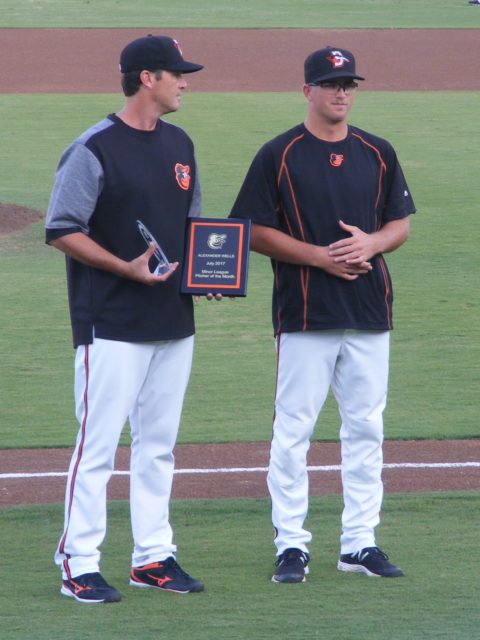
I wish I had hardware to give, but for now the pixels to officially dub Alex Wells as the Shorebird of the Year for 2017 will have to suffice. Next week will be my picks and pans feature speaking as a fan, and then in December I will update my Shorebird of the Week Hall of Fame. The Class of 2017 needs just one more to tie for largest, and it’s only a callup away.
Meanwhile, I’m already jonesing for a ballgame at the stadium. By the way, I’ve finally added the other photos I promised so now each month can be reviewed and they are how I intended them to be.
